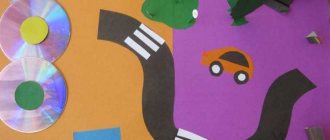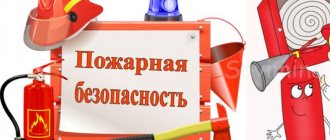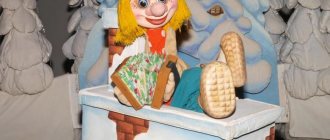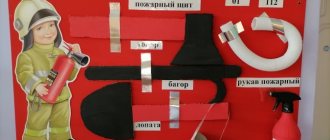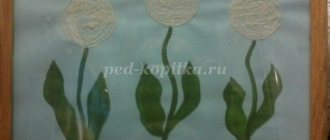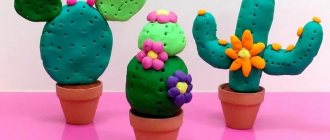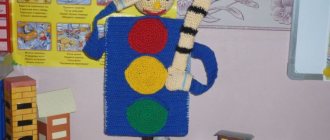Photo: clubvodoley.ru Kids love to create and experiment, and it is important to create suitable conditions for them to do this. Of course, there are all kinds of puzzles, construction sets and creativity kits, but I want more variety. In fact, all the best is already around us completely free. Catch 10 beautiful and easy ideas for crafts made from natural materials for kindergarten!
Chestnut caterpillar
If you drill through holes in the chestnuts in advance, you will get a toy no worse than children's pyramids. Let the child collect them on a wire or thick thread into a flexible and funny caterpillar.
Photo: m.fishki.net
Vegetable crafts for kindergarten: 10 beautiful and easy ideas
What can you do with children from pine cones?
Fir and pine cones are easy to process and ideal for making New Year's decorations, fairy-tale characters, animal figurines and decorative compositions.
Deer
Prepare:
- Two dry pine cones (opened);
- Thin branchy twigs, twig, scissors;
- Glue gun.
We are working:
Glue the large cone (torso) to the small one (head) so that the sharp part of the smaller cone faces up. Cut four identical sticks from the twig. Lubricate each one on one side with glue and stick it between the scales into the lower part of a large cone. There will be legs. Attach branchy twigs-horns to the head. Stick on the nose by rolling out a ball of red plasticine, and if you want, paint the figurine with silver paint.
Pine cone hare
A very simple job, for which you only need a pine cone and plasticine.
Roll out a figure shaped like a pear from white plasticine and get the head of a bunny. Stick on it blue balls-eyes, a white nose with a pink mark in the middle and a mouth that looks like an elongated red crescent. Insert pieces of toothpicks on both sides of the nose - a mustache. Attach long ears with pink accents to the top of your head. Make four thick cakes - legs, attach them to the body and the bunny is ready.
And if you get creative and put everything to work together: cones, acorns, sticks, pebbles, you can create complex compositions, such as seasons, Russian folk tales, everyday scenes. Try it, you will succeed!
Children's ornaments made from natural materials
Natural gifts allow you to endlessly create different abstract designs and ornaments. Maximum space for creativity, experimentation and self-expression!
Photo: infourok.ru
DIY winter crafts for kindergarten (50 photos)
Middle group. Junior preschool age. Children 4 - 5 years old
Summary of OOD on designing from natural materials in the middle group “Winter Tree” Municipal preschool institution kindergarten child development center No. 35 “Golden Key”
Abstract of the OOD on the artistic and creative development of children in the middle group Topic:
“Winter tree”
construction from
natural material Teacher of the middle group No. 2 Rzaeva Elena Fedorovna...
Abstract of a lesson on application in the middle group “Lamb using natural material” Program objectives: • introduce the main , additional colors and their shades, mastering the ability to create harmonious combinations; • develop compositional skills: build an image depending on the shape of the sheet; • learn to give a three-dimensional form to an image using...
Underwater world made of shells
Painted shells turn into strange fish, crabs and turtles. Add eyes, fins and claws to them and place them in a makeshift aquarium!
Photo: hobobo.ru
Crafts from pine cones for children: 10 simple and beautiful ideas
Cones
- Owl. The task is so simple that even a 5-year-old child can cope with it. To do this, you need to fill the space between the “scales” of the cone with cotton wool. Eyes and ears can be glued from paper, plasticine or acorn caps.
- Christmas tree. It is worth completely immersing the cone in the paint, and doing this several times in order to thoroughly paint the entire space deep between the scales. And then it will be interesting for the children to “dress up” the Christmas tree. Beads, ribbons, foil and even lace will help with this.
- A pineapple. Another simple craft that even the youngest kindergarten group can do on their own. Needed: Pine cone, yellow paint, green paper, glue, scissors, brush.
We do:- Paint the edges of the scales yellow, as in the photo.
- Cut a strip of paper 5cm wide. Leave it flat on one side and cut it on the other with sharp wedges (or like grass).
- Bend the edges of the “grass” using scissors. To do this, you need to run scissors along each wedge several times under pressure.
- Roll the paper into a tube. Glue its smooth part to the narrower side of the cone
Crafts made from natural materials for kindergarten – photos and ideas
And when your child tries all these options and ideas, explore our gallery of crafts with him!
Photo: fotovmire.ru Photo: kukolnik-shop.ru Photo: mammamia.blog
Photo: knowledge-tree.ru
Photo: ds37zaprudnoe.kinderedu.ru Photo: mydesigninfo.ru
Photo: viramaina.ru
Photo: podelunchik.ru Photo: les-tish.ru Photo: svoimirukamy.com
Photo: melkie.net Photo: tdconsource.ru Photo: larecmasterici.ru Photo: liveinternet.ru
Photo: m.ok.ru
Photo: exxxtreme-club.ru
Photo: vk.com
Photo: casasincreibles.com
Photo: tr.pinterest.com
Photo: art-talant.org
Did you like the post? Subscribe to our channel in Yandex.Zen, it really helps us in our development!
MAGAZINE Preschooler.RF
METHODOLOGICAL RECOMMENDATIONS FOR WORKING WITH NATURAL MATERIALNatural material itself is a storehouse for fantasy and imagination. And if you combine it with sleight of hand, then everything can be revived, given a second life, as it were.
Working with natural materials includes great opportunities for bringing a child closer to his native nature, developing a careful, caring attitude towards it and developing his first skills.
Making toys and crafts from natural materials is painstaking, exciting and very enjoyable work.
Making crafts requires dexterity from the child. In the process of systematic work, the hand gains confidence, accuracy, and the fingers become flexible. And this is important for preparing hands for writing and for educational activities at school. Manual labor contributes to the development of sensorimotor skills—coherence in the work of the eye and hand. Improving coordination of movements.
It is necessary to introduce children to the world of beauty as early as possible: pay attention to the beauty of flowers, the fruits of various plants, and autumn leaves. Each plant has a unique appearance: the shape of the leaves, their colors, etc., since when working with natural materials, everything must be taken into account.
I. How to organize work with natural materials. Supervise the work of children.
The methodology for organizing the work of preschool children with natural materials is based on the principles of didactics: systematicity, consistency, accessibility.
It is very important that the child acts actively and in good spirits. To do this, it is necessary to take into account its capabilities at the initial stage of organizing work, their further expansion and change. We can recommend that educators and parents first find out how children feel about manual labor, whether they want to work and what they can do. Children should be awakened to their interest in natural materials and their desire to act with them. In the group, it is necessary to organize exhibitions of children's works from natural materials, since children really like to look at finished materials made by their peers - everyone wants to learn how to make such toys.
Children work more successfully on making toys from natural materials if they have the opportunity to do it in other activities: in modeling classes, appliqué. Children love to make appliques from pumpkin seeds and dried leaves. During these classes, they get acquainted with a new technique for gluing appliques: they apply glue not to the part, but to the place where they will be applied.
When organizing work on making toys from natural materials, it is necessary to take into account the level of knowledge and practical skills of children. The production of a planned toy is preceded by extensive preparatory work for its creation. Excursions into nature are organized with children. During an excursion into nature, the teacher reminds children that the bark of dried or cut down trees and shrubs is used to make toys from natural materials. In front of the children, the teacher makes 1-2 simple toys, thereby arousing the children's interest in making crafts from natural materials. Collected dry roots and branches. Cones and knots have a bizarre shape. The teacher invites the children to answer the question: “What does it look like? What does it remind you of? Encourages the child to compare them, look carefully at the material, fantasize, think in advance what can be made from it.”
It is advisable to teach children how to make the same toy from different materials.
Making toys from natural materials consists of two stages:
- The child analyzes the toy that he has to make, plans the sequence of work on it, selects the necessary material, tools and determines the practical skills with which the goal will be achieved.
- The child begins to directly create the toy. It is explained to the children that work on a craft begins with preparing the workplace; during the work process, certain rules must be followed. First of all, they teach you to carefully analyze a sample of a future craft. Then the child is taught to analyze the process of upcoming work on the toy. The teacher demonstrates to the children the entire process of working on a toy from start to finish and shows how it is created. The teacher accompanies the demonstration of the work before each part, detail of the craft, and how to connect them with an explanation.
When creating toys, you can invite children to combine natural materials.
Scheme of the sequence of work for making crafts from natural materials according to the sample:
- Examination and analysis of a toy sample.
- Establishing a step-by-step sequence of its production and planning the progress of work.
- Choosing a method for connecting parts of a toy.
- Selection of materials and tools.
- Making a toy.
- Analysis and evaluation of crafts.
P. When and how to work.
In kindergarten, work with natural materials is organized in the first half of the day 2 times a month, and once a week - circle work (in the afternoon). You can study immediately with your group (if the crafts are simple) or in subgroups.
In the group and at home, conditions should be created for working with natural materials in their free time, a certain place where children, if desired, could engage in this activity.
How is a toy created, what operations need to be performed?
The simplest and most affordable way to connect parts of a craft is achieved using plasticine. A more complex, but also more durable way of connecting parts of a toy is gluing. You can also connect parts of the toy using twigs, matches, sticks, for which you will need an awl. The teacher does the main work with the awl. Parts can be connected with threads and wire.
Natural material:
cones (pine, spruce, larch, alder), nuts and their shells (walnuts, hazelnuts, cedar, earthen), chestnuts, acorns, bark, branches, roots, leaves, seeds, rose hips, rowan, corn cobs, straw, moss, birds feathers, shells.
Additional materials:
paper, foil, plasticine, wire, thread, PVC glue, colored scraps, plywood, pebbles, bones, fishing line, etc.
Tools:
awl, scissors, knife, needle, paper clip, brush, etc.
| Next > |
Extraordinary offers
Various figures are made from ordinary sticks, applying them to a template design, for example, in the form of a fish or a seahorse. By painting the branches in multi-colored colors with patterns, they create non-standard garlands or dream catchers.
It’s not difficult to tie a raft with sails from sticks, erect a lonely lighthouse, or cover them with acorn caps to depict a mushroom clearing.
Many people successfully use the bark, which, differing in thickness, texture and color, will act as an additional accessory or base for homemade products. Birch bark is used to make spectacular dolls or stylish hanging parts.
A separate topic is cones. From these you can construct:
- a pineapple;
- crocodile;
- penguins;
- gnomes;
- wreath;
- basket;
- dinosaur.
Sometimes you don’t need to do anything special, you just connect large cones to “trunks” stuck into wooden blocks, and a non-trivial forest appears that can be populated by forest dwellers.
The opened samples are painted in different shades and collected into an original bouquet.
No less fertile soil are shiny chestnuts with a thin shell. They are easily pierced, appearing in the form of caterpillars, snails and necklaces. I cover photo frames with them, just like any other elements.
You can create funny characters from acorns, and their hats are completely self-sufficient objects that are put on wool balls, getting a whole collection of charming colored heads. The acorn spider looks great on a thread web.
Crafts “Autumn Fantasies” for school (grades 1-4)
And now I propose to make a craft according to this master class in the style of modular origami. Wow, I’ve been asked for a long time to show how you can quickly and easily make maple leaves like this out of paper. So take note, because it is with these blanks that you can decorate the interior of a group, class, and even at a gala event, a matinee.
And then please, take it and fantasize. Here's how they decorated it on the Country of Masters website.
The next option, which is loved by younger schoolchildren, is of course the main character - a hedgehog.
In order to create it, you will need everything that you see in the picture below. This is colored paper, a glue stick, a felt-tip pen.
Take brown colored paper and fold it in half. Cut along the fold line with scissors, you will get two rectangles.
Then glue them together to form a stand.
After the glue has dried, draw and make round edges on the workpiece. Cut along the line. Using pink paper, also draw outlines in the form of a semi-oval.
It is also necessary to cut out round-shaped ears and paws from it. Arrange the parts in the correct proportions as shown below and glue to the base. Scatter real dry leaves or cut them out of colored paper.
Now all that remains for the hedgehog to do is make the spines; make cuts along the edge of the brown paper.
Draw the eyes and face. Your fabulous little animal is ready.
Using an accordion, make the work in the shape of trees. Look how original it looks.
Also, one of the favorite characters among children at any time of the year is the sun. I suggest making it this time from a CD. And again the paper will have to be folded like an accordion, in general, look at the instructions in the pictures and create.
What an unrealistically charming sun it turned out to be; my spirits lift when I see it.
And if you don’t have colored paper, then use napkins, although take them in a single color. Cut into small squares and roll each piece into balls.
Draw any still life, in this case the author depicted trees and a river. And sit and painstakingly glue each ball until the whole image is formed.
The next idea is work from cotton swabs, which, as you can see, were initially painted, their heads, in the desired color.
And for those who want to comprehend quilling, or are deeply interested in it, I would like to invite you to consider such a masterpiece.
Here's another fascinating idea, look how cool the author came up with it. Do you want to make it happen? Then let's get down to business. It will turn out to be just a living corner.
And if this is too difficult for you, then take a regular package and follow the photo description.
How to make an applique from leaves: quickly and beautifully
For such works, you can take absolutely any character and easily decorate it with dry leaves that you collected in the park. For example, you can lay out funny owls using cardboard and paper.
Or you can make a huge owl entirely out of leaves.
Or plant the birds on a branch decorated with bunches of rowan berries.
You can take any face, preferably some animal, cut it out, and then decorate it.
And with what, of course, leaves. Collect them and place them on a sheet of newspaper so that they do not shrink when drying.
Maple leaves are best suited as decoration, for example a lion.
Or perhaps you will be interested in working in the form of a little lion cub.
Today my kids and I made these creations. And we actually sat down to do it, and then my mother remembered that she forgot to buy glue. I’m thinking what to do, mine are about to go broke))). It's good that there was plasticine. And this is what happened.
You can easily build a vase using a balloon.
Or make an applique of seeds and plasticine.
Or you can imagine the work in the form of a three-dimensional toy.
